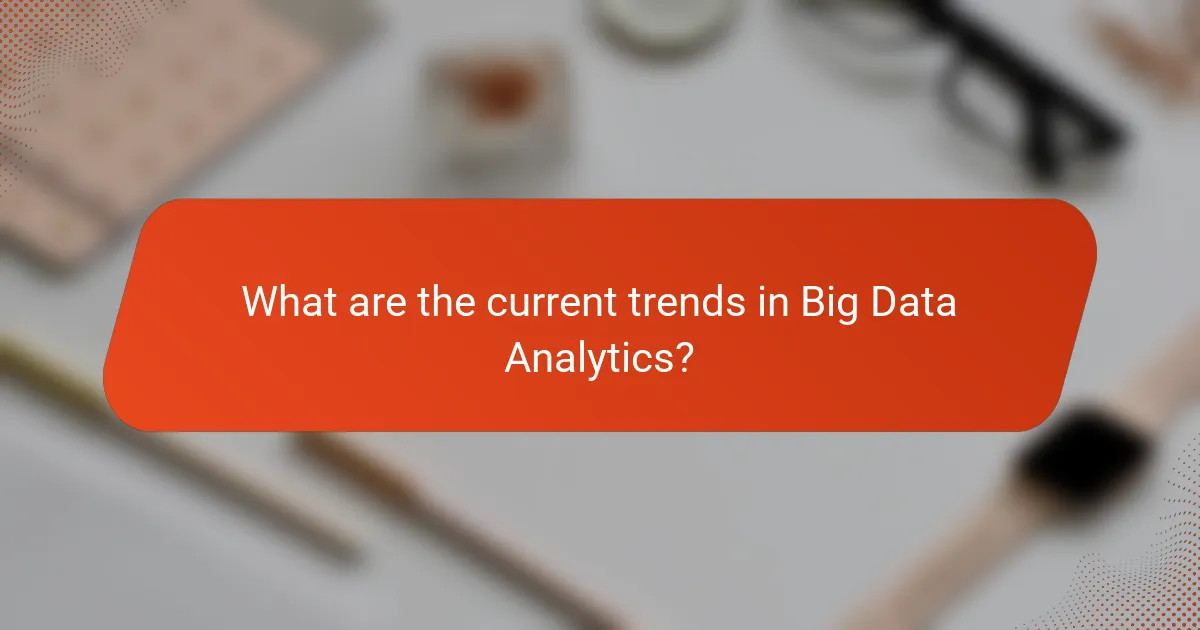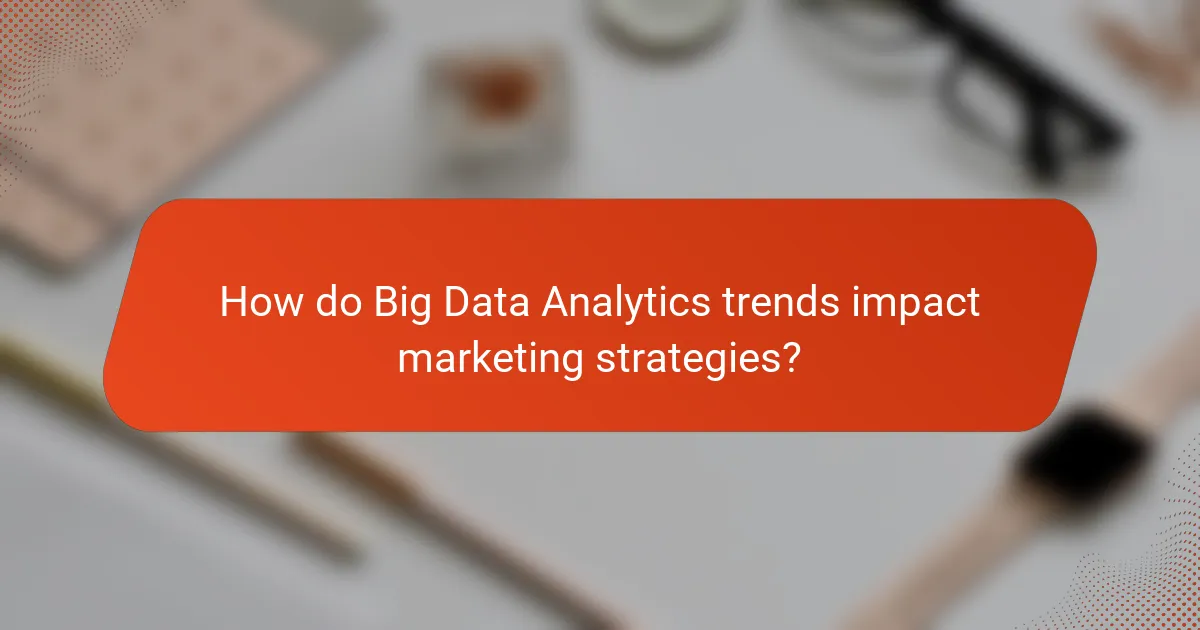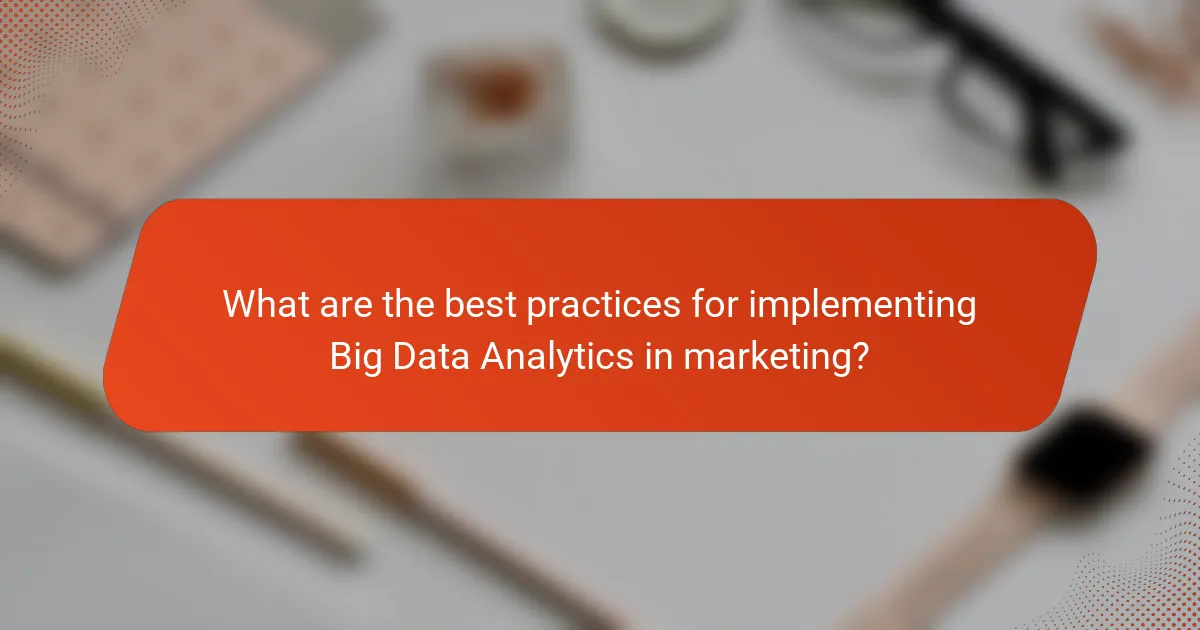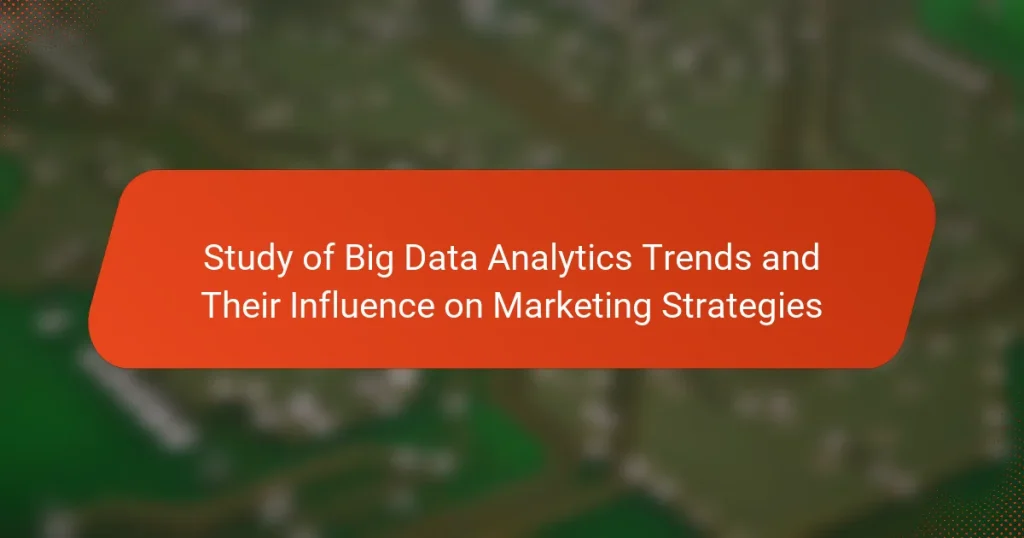Big Data Analytics encompasses the techniques and technologies used to analyze large datasets for insights that drive decision-making. Current trends in this field highlight the increased integration of artificial intelligence and machine learning, enhancing predictive analytics and automating data processing. Real-time data analytics is becoming essential for businesses to make immediate decisions, while data privacy and security are gaining importance due to regulatory changes. The article examines how these trends influence marketing strategies, emphasizing the role of data-driven decision-making in improving customer engagement and conversion rates. Best practices for implementing Big Data Analytics in marketing include establishing clear objectives, ensuring data quality, and leveraging advanced tools for comprehensive customer insights.

What are the current trends in Big Data Analytics?
Current trends in Big Data Analytics include increased adoption of artificial intelligence and machine learning. These technologies enhance predictive analytics and automate data processing. Real-time data analytics is gaining traction, allowing businesses to make immediate decisions. Additionally, there is a growing emphasis on data privacy and security due to regulatory changes. The integration of cloud computing facilitates scalable data storage and processing. Organizations are also focusing on data visualization tools to improve insights. Finally, the rise of edge computing enables processing data closer to the source, reducing latency. These trends are shaping how companies leverage data for strategic marketing decisions.
How is Big Data Analytics evolving in the marketing landscape?
Big Data Analytics is evolving in the marketing landscape by enabling more personalized and data-driven strategies. Marketers now leverage advanced algorithms to analyze consumer behavior in real-time. This shift allows for targeted advertising based on individual preferences and purchasing patterns. According to a report by McKinsey, companies using data-driven marketing are six times more likely to be profitable. Additionally, the integration of artificial intelligence enhances predictive analytics capabilities. This evolution leads to improved customer engagement and higher conversion rates. The trend towards automation in data analysis further streamlines marketing processes. Overall, Big Data Analytics is transforming how businesses connect with their customers.
What technological advancements are driving Big Data Analytics trends?
Artificial intelligence and machine learning are driving significant advancements in Big Data Analytics. These technologies enhance data processing capabilities and predictive analytics. Cloud computing enables scalable storage and processing power for large datasets. Internet of Things (IoT) devices generate vast amounts of real-time data, which analytics tools can leverage. Advanced data visualization tools are improving the interpretation of complex datasets. Blockchain technology is enhancing data security and integrity in analytics processes. Natural language processing (NLP) is enabling better insights from unstructured data sources. These advancements contribute to more effective marketing strategies by providing actionable insights.
How do consumer behaviors influence these trends?
Consumer behaviors significantly influence trends in big data analytics and marketing strategies. Changes in consumer preferences drive companies to adjust their data collection methods. For instance, increased demand for personalized experiences leads businesses to analyze consumer data more deeply. This results in tailored marketing campaigns that resonate with target audiences. Additionally, shifts towards sustainability prompt brands to track consumer sentiment regarding eco-friendly products. Data analytics helps identify these trends and informs strategic decisions. According to a report by McKinsey, companies that leverage consumer insights effectively can increase their marketing ROI by up to 30%.
Why is understanding Big Data Analytics important for marketers?
Understanding Big Data Analytics is crucial for marketers because it enables data-driven decision-making. Marketers can analyze consumer behavior and preferences through vast amounts of data. This analysis helps in targeting the right audience more effectively. According to a report by McKinsey, companies that leverage data analytics are 23 times more likely to acquire customers. Additionally, Big Data can enhance customer experiences by personalizing marketing efforts. It allows marketers to optimize campaigns in real-time, improving return on investment. Furthermore, understanding trends in data analytics helps in predicting future market movements. Overall, Big Data Analytics empowers marketers to make informed strategies that drive business growth.
What challenges do marketers face in leveraging Big Data Analytics?
Marketers face several challenges in leveraging Big Data Analytics. One significant challenge is data quality. Poor quality data can lead to inaccurate insights and decisions. Another challenge is data integration. Combining data from multiple sources can be complex and time-consuming. Additionally, marketers often struggle with data privacy regulations. Compliance with laws like GDPR can limit data usage. Skills gap is also an issue. Many marketers lack the necessary analytical skills to interpret complex data. Lastly, there is the challenge of data overload. Marketers may find it difficult to identify actionable insights amid vast amounts of data. These challenges hinder effective utilization of Big Data Analytics in marketing strategies.
How does Big Data Analytics enhance decision-making in marketing?
Big Data Analytics enhances decision-making in marketing by providing actionable insights from vast data sets. It allows marketers to analyze customer behavior and preferences in real-time. This analysis helps in targeting specific demographics effectively. For instance, companies can segment their audience based on purchasing patterns. Data-driven decisions lead to optimized marketing strategies. According to a study by McKinsey, companies that leverage data-driven marketing are 23 times more likely to acquire customers. Furthermore, predictive analytics can forecast future trends, enabling proactive marketing efforts. This results in increased ROI and customer satisfaction.

How do Big Data Analytics trends impact marketing strategies?
Big Data Analytics trends significantly impact marketing strategies by enabling data-driven decision-making. Marketers can analyze vast amounts of consumer data to identify patterns and preferences. This insight allows for more targeted advertising campaigns. Personalized marketing increases customer engagement and conversion rates. According to a report by McKinsey, companies using advanced analytics can improve their marketing ROI by 20-30%. Additionally, real-time data analysis helps marketers adapt strategies quickly based on current market conditions. This agility enhances competitiveness in rapidly changing environments. Overall, the integration of Big Data Analytics into marketing strategies leads to improved efficiency and effectiveness.
What specific marketing strategies are influenced by Big Data Analytics?
Big Data Analytics influences several specific marketing strategies. These include targeted advertising, customer segmentation, and personalized marketing. Targeted advertising utilizes data to reach specific demographics effectively. Customer segmentation divides audiences based on behavior and preferences. Personalized marketing tailors content and offers to individual users. According to a 2020 report by McKinsey, companies using data-driven marketing strategies see a 5-8 times higher ROI. This demonstrates the effectiveness of leveraging Big Data in marketing.
How does segmentation improve with Big Data Analytics?
Segmentation improves with Big Data Analytics by enabling more precise targeting of consumer groups. Big Data Analytics processes vast amounts of data from various sources. This includes social media, transaction histories, and online behavior. Such data reveals intricate patterns in consumer preferences and behaviors.
With advanced algorithms, businesses can identify micro-segments within broader markets. These micro-segments allow for tailored marketing strategies that resonate with specific audiences. For instance, a study by McKinsey found that companies using data-driven segmentation achieve 5-10% higher revenue.
Moreover, real-time analytics facilitate dynamic segmentation. This means businesses can adjust their strategies based on current consumer trends. Consequently, segmentation becomes more responsive and effective. Overall, Big Data Analytics enhances segmentation by providing deeper insights and enabling targeted marketing efforts.
What role does personalization play in marketing strategies influenced by Big Data?
Personalization enhances marketing strategies influenced by Big Data by tailoring content to individual preferences. It allows brands to deliver targeted messages based on consumer behavior and demographics. This approach increases engagement and conversion rates. According to a study by Epsilon, 80% of consumers are more likely to make a purchase when brands offer personalized experiences. Big Data analytics enables marketers to analyze vast amounts of data quickly. This analysis identifies trends and patterns, which inform personalized marketing efforts. Personalization, therefore, is a crucial component in maximizing the effectiveness of marketing strategies driven by Big Data.
Why should businesses adapt their marketing strategies based on Big Data Analytics trends?
Businesses should adapt their marketing strategies based on Big Data Analytics trends to enhance decision-making and customer engagement. Big Data enables companies to analyze vast amounts of consumer data quickly. This analysis reveals patterns and preferences that inform targeted marketing efforts. For instance, a study by McKinsey found that companies using data-driven marketing are six times more likely to be profitable. Adapting strategies based on these insights leads to more personalized customer experiences. Additionally, businesses can optimize their marketing spend by focusing on high-performing channels identified through data analysis. Ultimately, leveraging Big Data trends helps businesses stay competitive and responsive to market changes.
What are the risks of not adapting to these trends?
The risks of not adapting to big data analytics trends include losing competitive advantage and decreased market relevance. Companies that ignore these trends may fall behind in understanding customer behavior. This can lead to ineffective marketing strategies that do not resonate with target audiences. Additionally, failure to leverage data insights can result in poor decision-making. The inability to personalize customer experiences may drive consumers to competitors. A study by McKinsey & Company indicates that companies using data analytics improve their productivity by 5-6%. Without adaptation, businesses risk stagnation and potential decline in revenue.
How can businesses measure the effectiveness of their data-driven marketing strategies?
Businesses can measure the effectiveness of their data-driven marketing strategies through key performance indicators (KPIs). KPIs such as conversion rates indicate how many leads turn into customers. Tracking return on investment (ROI) helps assess the financial impact of marketing efforts. Customer acquisition cost (CAC) provides insight into the cost-effectiveness of gaining new customers. Engagement metrics, like click-through rates (CTR), show how well marketing content resonates with the audience. Additionally, analyzing customer lifetime value (CLV) helps determine long-term profitability from customers. Utilizing analytics tools allows businesses to gather and interpret this data effectively. Regularly reviewing these metrics ensures ongoing optimization of marketing strategies.

What are the best practices for implementing Big Data Analytics in marketing?
The best practices for implementing Big Data Analytics in marketing include establishing clear objectives, ensuring data quality, and leveraging appropriate tools. Clear objectives guide the analytics process and align with business goals. High-quality data is essential for accurate insights and decision-making. Utilizing advanced analytics tools enables marketers to analyze large datasets effectively.
Additionally, integrating data from various sources provides a comprehensive view of customer behavior. Regularly updating data models ensures they remain relevant and effective. Training staff on data analytics fosters a data-driven culture within the organization. Finally, measuring the impact of analytics initiatives allows for continuous improvement and optimization of marketing strategies.
How can businesses effectively collect and analyze data?
Businesses can effectively collect and analyze data by implementing structured methodologies and leveraging technology. First, they should establish clear objectives for data collection. This ensures that the data gathered aligns with business goals. Next, businesses can utilize various data collection methods such as surveys, interviews, and web analytics. These methods provide diverse data sources for comprehensive analysis.
Additionally, businesses should invest in data management tools and software. These tools facilitate the organization, storage, and retrieval of data. They also enhance data quality and accessibility. Once data is collected, businesses can employ statistical analysis and visualization techniques. This helps in identifying trends and insights from the data.
Moreover, adopting machine learning algorithms can automate data analysis processes. This allows for real-time insights and predictive analytics. According to a report by McKinsey, companies that leverage data-driven decision-making are 23 times more likely to acquire customers. This statistic underscores the importance of effective data collection and analysis in driving business success.
What tools are recommended for data collection and analysis?
Recommended tools for data collection and analysis include Google Analytics, Tableau, and Microsoft Excel. Google Analytics tracks website traffic and user behavior. Tableau visualizes data insights effectively. Microsoft Excel offers powerful data manipulation and analysis capabilities. These tools are widely used in marketing strategies to enhance decision-making. Studies show that businesses using these tools can improve their marketing effectiveness by up to 30%.
How can businesses ensure data quality and integrity?
Businesses can ensure data quality and integrity by implementing robust data governance practices. This includes establishing clear data management policies. Regular data audits help identify inconsistencies and errors. Training employees on data entry standards reduces human errors. Utilizing data validation tools can automatically check for inaccuracies. Implementing access controls protects data from unauthorized modifications. Regularly updating data systems ensures they meet current standards. These practices collectively enhance the reliability and accuracy of business data.
What are the key considerations for developing a data-driven marketing strategy?
Key considerations for developing a data-driven marketing strategy include understanding customer data, defining clear objectives, and selecting appropriate metrics. Customer data provides insights into preferences and behaviors. Clear objectives guide the strategy and help measure success. Appropriate metrics, such as conversion rates and customer lifetime value, track performance effectively. Additionally, leveraging advanced analytics tools enhances data interpretation. Integrating data sources ensures a comprehensive view of customer interactions. Regularly reviewing and adjusting the strategy based on data insights is crucial for continuous improvement. These considerations align with industry best practices, as 67% of marketers prioritize data-driven decisions for campaign effectiveness.
How should businesses prioritize data privacy and compliance?
Businesses should prioritize data privacy and compliance by implementing robust data protection policies. They must conduct regular risk assessments to identify vulnerabilities in their data handling processes. Training employees on data privacy regulations is essential to ensure compliance. Businesses should also adopt encryption and anonymization techniques to protect sensitive information. Regular audits can help verify adherence to privacy laws. Establishing a clear data breach response plan is crucial for minimizing damage. Compliance with regulations like GDPR and CCPA is mandatory for legal operation. Research indicates that 79% of consumers are concerned about data privacy, highlighting the importance of prioritizing this issue.
What common pitfalls should businesses avoid in Big Data Analytics implementation?
Businesses should avoid several common pitfalls in Big Data Analytics implementation. One major pitfall is failing to define clear objectives. Without specific goals, analytics efforts can become unfocused and ineffective. Another pitfall is neglecting data quality. Poor quality data can lead to inaccurate insights and misguided decisions.
Additionally, businesses often underestimate the importance of skilled personnel. Lack of expertise can hinder the ability to analyze and interpret data correctly. Ignoring data privacy regulations is another critical mistake. Non-compliance can result in legal issues and damage to reputation.
Furthermore, businesses may struggle with integrating data from multiple sources. Inconsistent data formats can complicate analysis and reduce effectiveness. Lastly, companies sometimes overlook the need for continuous evaluation of analytics processes. Regular assessments are vital for optimizing performance and adapting to changing market conditions.
What practical tips can marketers follow to leverage Big Data Analytics effectively?
Marketers can leverage Big Data Analytics effectively by focusing on data quality, integration, and actionable insights. Ensuring high data quality is essential for accurate analysis. Poor data can lead to misguided strategies. Integrating data from various sources provides a comprehensive view of customer behavior. This holistic approach enhances targeting and personalization.
Utilizing advanced analytics tools allows marketers to uncover patterns and trends. Predictive analytics can forecast customer preferences and behaviors. This enables proactive marketing strategies. Additionally, fostering a data-driven culture within the organization encourages teams to make informed decisions.
Regularly reviewing and adjusting strategies based on analytics findings is crucial. This iterative process ensures continuous improvement and relevance in marketing efforts. By prioritizing these practices, marketers can maximize the benefits of Big Data Analytics.
The main entity of the article is Big Data Analytics and its trends influencing marketing strategies. The article explores current trends such as the adoption of artificial intelligence, machine learning, and real-time data analytics, emphasizing their impact on personalized marketing and decision-making. It highlights the technological advancements driving these trends, the challenges marketers face, and the importance of data quality and integration. Additionally, the article discusses best practices for implementing Big Data Analytics, measuring effectiveness, and ensuring data privacy and compliance. Overall, it provides a comprehensive overview of how Big Data Analytics is transforming marketing strategies and enhancing business outcomes.




